|
||||||||||
|
|
||||||||||
|
||||||||||
|
|
||||||||||
|
|
|
||||||||||
|
Now that we have explored the properties of hypersonic flows, hypersonic
aerodynamics, and theoretical waverider designs, you may
be wondering if any vehicle utilizing these concepts has or ever will fly. We will now discuss a few of the more
common applications of hypersonic vehicles.
XB-70 Valkyrie:During the mid-1950s, the US Air Force saw the need for a very high-speed, high-altitude bomber to replace subsonic designs like the B-52. A Mach 3 bomber flying at 80,000 ft or more, they reasoned, should be nearly impossible for enemy interceptors or missiles to catch. Although the original request for proposal called for a subsonic cruise with only a Mach 3 dash capability, North American Aviation engineers utilized the flat-top wing with tip flaps concept to produce an XB-70 prototype (shown below) that cruised at Mach 3 for over 7,500 miles. The B-70 wing was so highly tailored to its design Mach speed that cruising any slower greatly reduced this range. In case of an engine failure, specifications actually called for the aircraft to go to afterburner. Despite the great increase in fuel consumption, maintaining Mach 3 was far more vital to meeting the range requirement because of the estimated 35% increase in lift due to compression lift. Although the expensive bomber program eventually succumbed to budget cuts, two prototypes were built and used by NASA to conduct high-speed research during the mid-1960s. Many see the B-70 as the stepping stone between supersonic and hypersonic flight.

XB-70 Valkyrie Mach 3 research aircraftNational Aerospace Plane (NASP) and X-30:During the 1980s, NASA began considering a hypersonic single-stage-to-orbit (SSTO) vehicle to replace the Space Shuttle. The proposed National Aerospace Plane (NASP) would take off from a standard runway using some kind of low speed jet engine. Once the aircraft had reached sufficient speed, air-breathing ramjet or scramjet engines would power the aircraft to hypersonic velocities (Mach 20 or more) and to the edge of the atmosphere. A small rocket system would provide the final push into orbit, but the attractiveness of the concept was using the atmosphere to provide most of the fuel needed to get into space. NASP eventually matured into the X-30 research vehicle, illustrated below, which used an integrated scramjet propulsion system.

X-30 hypersonic scramjet SSTO conceptThe X-30 was intended to replace the Space Shuttle but was cancelled in the early 1990s due to escalating costs and lack of military support. X-43 Hyper-X:NASAís Hyper-X project, now known as the X-43 illustrated below, will be the first vehicle using an air-breathing engine ever flight tested at hypersonic speeds.
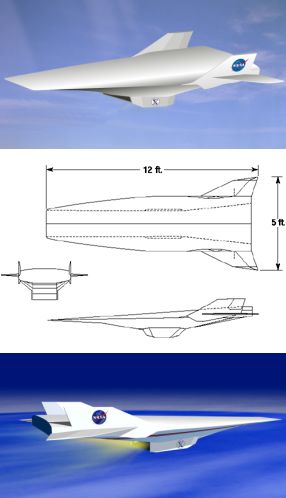
X-43 Hyper-X scramjet test aircraftLooking much like a scaled-down X-30, the Hyper-X is a small, unpiloted vehicle intended to test an integrated scramjet engine from Mach 7 to 10. To become airborne, the X-43 will be mounted on the nose of a Pegasus rocket carried aloft and released by a B-52. The Pegasus will power the test craft to about 100,000 ft and the desired test speed before the X-43 separates and its scramjet engine engages. The Hyper-X will only fly for a few seconds before falling into the ocean, but data collected from these test flights will be used to develop practical hypersonic scramjet engines for future vehicles. The first X-43 test flight, conducted in June 2001, ended in failure after the Pegasus booster rocket became unstable and went out of control. NASA believes the fault has been corrected, and a second attempt is planned for early summer of 2003. This flight will repeat the failed attempt to cruise at Mach 7 while a third flight at Mach 10 is scheduled for 2004. In addition, three follow-on models are also being considered. First of these is the X-43C which will test a hydrocarbon-fueled dual mode scramjet being developed by Pratt & Whitney under the Air Force's HyTech program. The HyTech engine is expected to accelerate the enlarged X-43C from Mach 5 to Mach 7. Two propulsion concepts are currently being considered for an X-43B model. First of these is a rocket-based combined cycle (RBCC) engine under development by Aerojet, Boeing, Pratt & Whitney, and Rocketdyne. The RBCC engine is a new technology using a rocket engine fed by oxygen from the atmosphere rather than carried aboard the vehicle. The effort is being funded by NASA Marshall under the Integrated Systems Test of an Airbreathing Rocket (ISTAR) program. Meanwhile, an alternative propulsion arrangement is being developed at NASA Glenn as part of the Revolutionary Turbine Accelerator (RTA) program. The RTA engine uses a turbine-based combined cycle (TBCC) to push turbojet technology to much higher speeds than is possible with current jet engines. Regardless of the engine eventually selected, plans call for the vehicle to be air-launched at Mach 0.8 and accelerate to Mach 7 or 8 over 10 minutes. The RTA engine would accerate to about Mach 5 where a HyTech engine like that used on the X-43C would take over. Both the RBCC and TBCC vehicles would be able to glide down for landing and reuse permitting up to 25 flights. A final proposal is for an X-43D, an evolved version of the original X-43A. While the X-43A is powered by an uncooled hydrogen-fueled scramjet engine, the X-43D would use a cooled, liquid-hydrogen-fueled scramjet. The upgraded engine would provide 10 seconds of power and be capable of accelerating to Mach 15. LoFlyte:Previously, we looked at the stability and control characteristics of waverider-type vehicles. To further research in this area, the Air Force and Navy sponsored the LoFlyte test vehicle to study the flight characteristics of a waverider at low-speed conditions, like takeoff and landing. LoFlyte is another small, unmanned vehicle that can be reconfigured with different types of control surfaces and flight control algorithms to determine the most effective combination. Though designed using a Mach 5.5 conical flowfield, the LoFlyte vehicle, shown below, is not actually capable of flying at hypersonic speeds. It has instead been tested for basic handling characteristics at low-speeds.
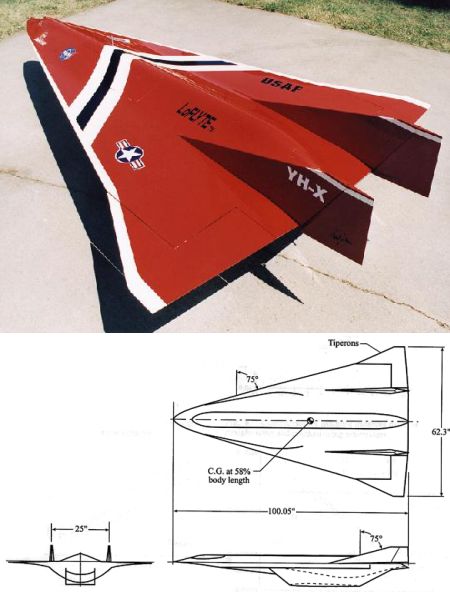
LoFlyte low-speed handling test vehicleCommercial Transports:Hypersonic vehicles in general and waveriders in particular have long been touted as potential high-speed commercial transports to replace the Concorde. Some aerospace companies, airlines, and government officials have proposed vehicles cruising at Mach 7 to 12 capable of carrying passengers from New York to Tokyo in under two hours.

Hypersonic commercial transportPerhaps one of the most well-known concepts along these lines was the Orient Express, envisioned as a commercial derivative of the NASP project. Shown above is a more recent artists concept of a hypersonic transport in American Airlines markings. Military Applications:Probably the greatest proponent of hypersonic travel over the years has been the United States military. Trends of the 1950s and 1960s indicated that military aircraft had to fly faster and higher to survive, so concepts for high-altitude fighters and bombers cruising at Mach 4 or more were not uncommon. Although the trend soon fizzled and military planners looked to maneuverability and stealth for survival, the military has recently shown renewed interest in hypersonic flight. For example, many have conjectured about the existence of a Mach 5 spy plane, the Aurora, that may be under development or perhaps already flying. If so, the Aurora may be a scramjet-powered design similar to the X-30 and X-43 research vehicles. An artistís concept is shown below.
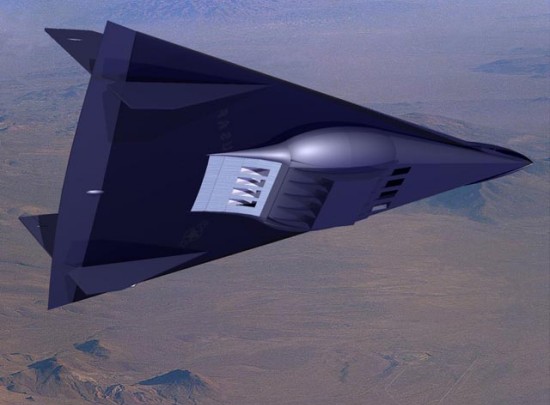
Possible Aurora Mach 5 reconnaissance aircraft configurationMore recently, Northrop Grumman has unveiled a concept for a hypersonic bomber designed using waverider principles, illustrated below.

Northrop-Grumman hypersonic waverider bomber conceptLike a commercial transport, the attractive feature of a hypersonic bomber is the ability to reach any location in the world in a matter of hours from bases in the United States. Whether or not the military decides to proceed with development of such an aircraft remains to be seen. In the current climate of budget cutbacks, it seems unlikely that anything more than basic research in this area will be conducted for at least the next several years. Cruise Missiles:Though developing a man-rated hypersonic vehicle like those described above will likely require decades of work and enormous cost, militaries around the world will likely have hypersonic cruise missiles entering service by 2015. Most current concepts for high-speed missiles are simple cylinders with no relation to waveriders. However, both the US Air Force and US Navy have shown interest in more unconventional configurations that could offer great advantages in reducing drag and increasing range.
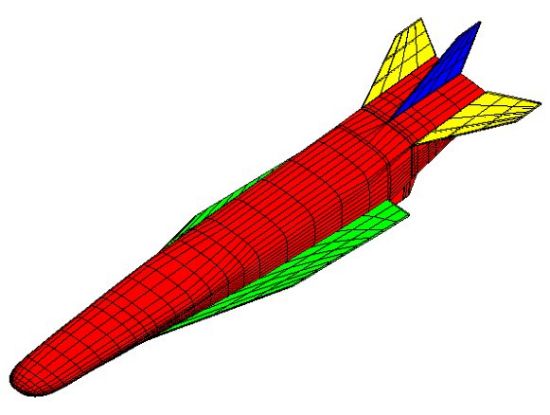
AFRL concept for a dual-combustion ramjet demonstratorAn Air Force Research Lab (AFRL) concept for a Mach 5 cruise missile demonstrator is illustrated above. The missile bears some resemblance to the X-43 since the propulsion system in mounted underneath the body and utilizes the forebody as a compression ramp. The vehicle would be about 15.8 ft (4.8 m) in length, weigh about 2,000 lb (905 kg), and be powered by an integrated dual-combustion ramjet.
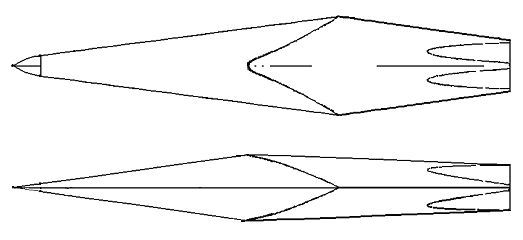
Supersonic Lifting BodyAnother interesting vehicle design, called the Supersonic Lifting Body (SSLB), comes from the US Navy. The SSLB is designed to fly between Mach 3 and 5, and can be adapted to use either a solid rocket motor, ramjet, or advanced turbine engine for propulsion. The vehicle does not specifically employ waverider design concepts, but does achieve many of the same advantages in reducing wave drag at high speeds. The SSLB sacrifices some aerodynamic efficiency in comparison with a waverider, but is far more compact and better suited to the volume, length, and width requirements of a weapon system. The vehicle generates much of its lift by creating strong vortices along the chined leading edge. These vortices accelerate the flow over the upper surface of the vehicle creating large regions of low pressure. The principal advantage of these and other hypersonic missile concepts is the ability to attack time-critical targets (TCTs), such as mobile vehicles, in much less time than is possible with today's long-range weapons. An aircraft or naval ship armed with hypersonic missiles could loiter far outside the combat zone while air- and space-reconnaissance platforms searched for appropriate targets. Once a target were detected and its precise coordinates determined, the launch platform would fire a missile to destroy the TCT before it had the opportunity to change location. |


|
Aircraft | Design | Ask Us | Shop | Search |

|
|
| About Us | Contact Us | Copyright © 1997-2023 | |||
|
|
|||